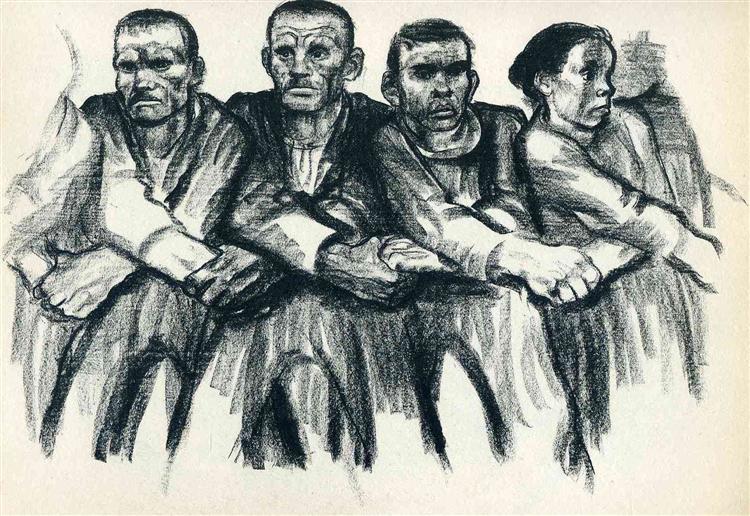The refugees who tried to save themselves by crossing the frontiers: hated by the fascists for being communists, hated by the Nazis for being Jews, and hated by the democracies for their being anti-capitalists. By João Bernardo

In the early days of July 1940, off the Irish coast, a German submarine attacked and sank a ship carrying around 1200 civilian passengers. More than half died, not least because the ship did not have enough lifeboats.
But what were these people doing on the high seas in such circumstances? At the start of June the Allied troops had been evacuated from Norway, leaving the country to the Nazis, while the French authorities signed an amnesty a few days later, on 22nd June. Denmark, Holland and Belgium were also occupied by the Nazi forces, which meant the encirclement of Great Britain by a hostile Europe. The situation was all the more grave given that the United States was still not a belligerent country and the Soviet Union was tied to the Third Reich by a series of accords ensuring its neutrality, usually called the Nazi-Soviet Pact, including the German-Soviet Non-Aggression Treaty signed on 23rd August 1939 and the German-Soviet Treaty of Friendship, Co-operation and Demarcation, signed on 23rd September of that same year. This was hardly a time for tourism, nor could these 1200 passengers have been fugitives seeking safe asylum on the other side of the Atlantic, given that all means of maritime transport had been requisitioned for the war effort and the authorities would not have put them at the service of feeble-spirited civilians. So who were these people, and what explains their going to such lengths?

The more than one thousand passengers of the ship sunk by the German submarine were of German, Austrian and Italian nationality, who the British government had decided to deport to Canada. Some of them had long been living in Britain, including anti-Nazis and anti-fascists who had found refuge there; others were there for work reasons when war was declared: and all of them were collectively considered suspect. It was later made clear that none of them were enemy agents, but the British government could not have been sure of this at the time, and German intelligence was indeed reinforced by its links among its compatriots based in other countries. But what explains why anti-fascist refugees, who had proven their hostility to the regimes of Mussolini and Hitler, were also deported. How to explain the fact that among the 600 dead were counted numerous anti-fascists, some well known, who the British authorities sacrificed even when they had managed to escape?
In October 1939 the British authorities had decreed the immediate detention of all German and Austrian foreign residents, who were effectively considered a danger to national security. The criteria were widened in May 1940 with the internment in concentration camps of all adult males of German and Austrian origin resident in the south east and east of England, a measure extended to Italians upon Italy’s entry into the war in May 1940. Meanwhile, the Interior Minister decided on the detention of all persons nationwide originating from enemy countries, even if they had no specific suspicion over their heads. By July 1940 27,000 people had already been detained, and even if some of them were known partisans of Hitler and Mussolini, many others had emigrated for political reasons and were long-time anti-fascists or Jewish fugitives from the Reich. But they all had the same fate: all were detained together and treated the same. Of these, around 7,500 were send to Canada or Australia, while in Great Britain more and more internment camps for foreigners were established, with the Isle of Man converted into a veritable complex of concentration camps.
So we start to see the reason why the foreign fascists were held prisoner together with other suspects when we observe that in October 1939, when the UK authorities decreed the immediate detention of German and Austrian residents, effectively considered to be a danger to national security, the British fascists, even the most fanatical apologists for Hitler, remained at liberty and continued to profit from wide-ranging organisational freedoms. Only in May 1940 were the main fascist leaders imprisoned, and even this was several days after the order for internment of Germans and Austrians living in the south-east and east of England. The London government evidently feared Nazi espionage, but also whatever political activity which, as had happened two decades before, sought to transform the war into a revolution. There was a two-pronged campaign against both the foreign enemy and the risk of domestic subversion. Indeed the concerns of the government were aggravated by the fact that a considerable part of the population expressed hostility to the internment of foreigners, in spite of various media, both of the Conservative right and the Labourite left, conducting an alarmist campaign against immigrants and refugees. Ultimately, the British authorities gradually freed those few foreigners who remained in detention at the end of the war. The Soviet Union’s participation in the Allied side, from June 1941, and the dissolution of the Communist International in May 1943, appeared to offer sufficient guarantees that the inter-imperialist conflict would not be transformed into a working-class revolution.

The policy adopted by the government had impeccable democratic credentials, given that the French government had done just the same to those who, having fought in defence of the Spanish Republic and expecting the final advance of Franco’s troops, sought refuge on the other side of the Pyrenees. Arthur Koestler met some of them a few months later in the Le Vernet concentration camp in southern France, where they were confined, and reported on their fate in an uncommon work: “Barrack 32 was a real hell. There was complete darkness and a nauseating odour. None of those who lived there had a change of clothes or underwear, and many had literally sold their last shirt in exchange for a pack of cigarettes, and walked around naked but for a thin and tattered coat. The barrack was infested with parasites and diseases. Outside of working hours, the prisoners carried out little chores for the other prisoners, watching their clothes, repairing their shoes or cleaning their boots in exchange for a few pieces of bread. They did not receive or send letters. They wandered through the concentration camp, picking up cigarette subs from the ground or the floor of the toilets, where it was easier to find them. Even the
worst-off of the other barracks looked on them with a sense of horror and intimidation. These one hundred and fifty men who populated the so-called Lepers’ Barracks were what remained of the International Brigades – they who represented the pride of the European revolutionary movement, the vanguard of the left”.

But what was Arthur Koestler doing there: he who, born in Hungary to a Jewish family, former member of the German Communist Party and agent of the Communist International, war correspondent imprisoned by Franquist troops and condemned to death in February 1937, freed in June thanks to an international campaign, who broke with communism in 1938 but continued to be an anti-fascist? Soon after the early days of September 1939, when it had declared war on the Reich, the French government confined in stadiums – Pinochet’s army invented nothing – and afterwards in detention camps, not only suspect foreigners, but so too the anti-fascists of Germany, Italy and central Europe, and even those originating from still-neutral countries, as was the case with the Hungarian Koestler, to whom in the old democratic days they had granted a guarantee of liberty. Ernst von Salomon wrote of the similar case of a German Jewish writer, who suffered the same fate in spite of his son’s service in the French army.
“Police wearing helmets and carrying loaded guns surrounded the student cafés of the Boulevard Saint-Michel”, recounted lifelong revolutionary Victor Serge. “The foreigners who did not have their papers in order were led into vans and taken to the police station. Many were anti-Nazi refugees, because the other foreigners had their papers in order. […] The anti-Nazi and anti-fascist refugees came to know of new prisons, those of the republic which was their last place of refuge on this continent and which now fretted and lost its head. Spaniards and combatants of the International Brigades who the fascists had defeated in Madrid were treated as if they had the plague… With the right papers and a proper passport, Spanish Falangists, fascists from still-neutral Italy and Russian Whites – and who knows how many undercover Nazis using these easy disguises – freely passed through the whole of France”. At this time the official paper of the Nazi Party published a list of anti-Nazi writers who the French authorities had forced into concentration camps, and asked at the end, with heavy sarcasm, if they were still convinced of the advantages of democracy. The response came in the inscription a Spanish refugee carved on a cross standing at the grave of his comrade in Le Vernet. “Adios, Pedro. The fascists want to burn you alive but the French will let you die of cold in peace. So long live democracy”.
If this does not suffice to show that the democratic governments were not imprisoning potential enemy spies but rather potential revolutionaries, let us note that the French far-right, apologists for Hitler and Mussolini and who hated and scorned the democratic system, enjoyed a conspicuous impunity during the ‘phoney war’, as the eight months of military inactivity were labelled. The inertia of the French troops, avoiding crossing the Reich’s borders and abstaining from going on the offensive, makes more sense when we remember that the government had given responsibility to officials who had participated in the far-right intrigue during the Popular Front, and even former leaders of the conspiracy were incorporated into the armed forces. These people were more afraid of revolution than of Hitler and had desired the victory of the Reich in order to finish off the revolutionary threat.

Only when collapse was imminent and the German army was approaching Paris did the Interior Minister order the arrest of half a dozen journalists and politicians who were notorious apologists for Hitler. At the same time, nevertheless, those few German and Austrian exiles who had remained at liberty returned to detention, including all the leaders and significant figures in the anti-Nazi opposition. In June 1940, when the French generals signed the Armistice, the foreign anti-fascists detained in the concentration camps were either handed over to the occupying authorities or remained under the control of the Vichy collaborationist government, although a few managed to escape and others committed suicide, many well-known names among them. This was the situation with Walter Benjamin, who killed himself with a capsule of cyanide given to him by Koestler in case he did not manage to escape.
Such were the ‘shipwrecked’, those who had fought in various countries and tried to save themselves by crossing the frontiers, hated by the fascists for being communists, hated by the Nazis for being Jews – in their eyes Jews and communists were the same thing – and hated by the democracies for their being anti-capitalists. These anti-fascist refugees were the first victims of the military conflict between the democracies and the fascist countries. But why did they not try and escape to the Soviet Union? Was this not the natural place of exile for communists and anti-fascists? Did the shipwrecked perish simply because they were in the wrong place at the wrong time?
Continues here.
References
Regarding the British government’s policies on émigrés from Axis countries during World War II see Angus Calder, The Myth of the Blitz, London: Jonathan Cape, 1991, especially from page 110. But as such the theme of this article has not preoccupied historians, and I only know of one book dedicated to the question, and this is not thanks to a historian by the journalist, novelist and essayist Arthur Koestler’s Scum of the Earth, London/New York, Hippocrene, 1991. The first quotation, on the Lepers’ Barracks, is found on page 114. The case described by Ernst von Salomon appears in his book Le Questionnaire, Paris, Gallimard, 1993, page 268. The Victor Serge quote is taken from his work Mémoires d’un Révolutionnaire, 1905-1941, included in Jean Rière and Jil Silberstein (eds.) Victor Serge. Mémoires d’un Révolutionnaire et autres Écrits Politiques, 1908-1947, Paris, Robert Laffont, 2001, page 800. The sarcasms of the Völkischer Beobachter, official paper of the Nazi Party, are cited in Koestler, op. cit., page 133. The inscription on the grave in Le Vernet is mentioned in Arthur Koestler, The Yogi and the Commissar and Other Essays, New York: Collier, 1961, pages 79-80.
Translate by The Commune. Original here.






